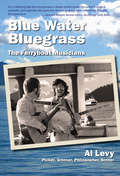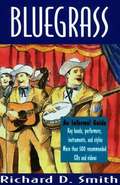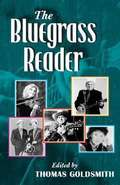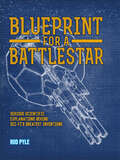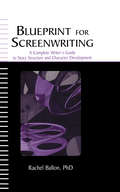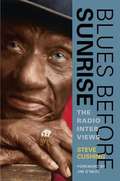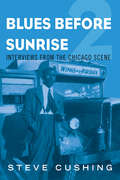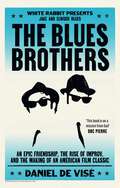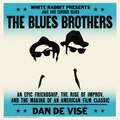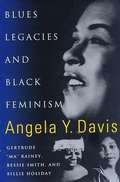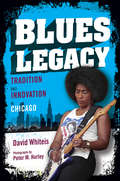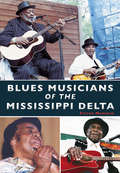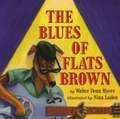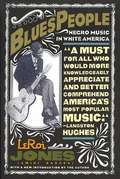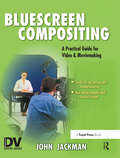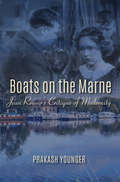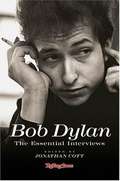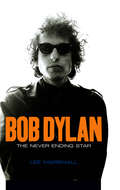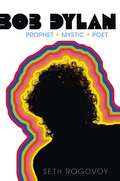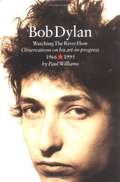- Table View
- List View
Blue Water Bluegrass: The Ferryboat Muscians
by Al LevyThis is a story of a magical time and place that was very real. Magic is the power to transform. See for yourself how a couple of young men transformed an ordinary ferry ride into Ferryboat Music. Their music touched and changed the lives of thousands who saw them every weekend on the sparkling waters of Puget Sound. This is a story of transforming fear into love, mundane into miraculous, and isolation into connection. Feel the heart and the humor in every story in these pages.
Bluegrass: An Informal Guide
by Richard D. SmithCreated by legendary Bill Monroe of Kentucky and made famous by his Blue Grass Boys, bluegrass has been sweeping musicians and audiences off their feet since 1939. This lively and authoritative guide covers: all the important sounds from traditional Monroe-style bluegrass, jazz-flavoured northern 'newgrass', and Nashville-influenced country grass to the distinctive sounds of Japanese and European bands; famous groups, instrumentalists, and vocalists; women blue grassers; with insider anecdotes, resource listings, the lowdown on bluegrass festivals, and more than 500 recommendations for listening.
The Bluegrass Guitar Style of Charles Sawtelle
by Daniel MillerBook description from the Flatpicking Guitar magazine website (where I bought it!) Charles Sawtelle is one of the most innovative guitar players in bluegrass history. His bluesy syncopated solos with the popular bluegrass band Hot Rize proved true the famous saying 'less is more.' Charles is a true master of tone, timing, and taste in bluegrass guitar playing and his exciting and innovative solos have thrilled bluegrass fans around the world. This comprehensive book provides you with a Sawtelle biography, an extensive interview with Charles, a section on Charles' rhythm style, 27 transcriptions of Sawtelle solos in both standard notation and tablature, with notes accompanying each solo transcription and dozens of photographs of Charles and Hot Rize. All fans of Hot Rize will love this book. Level: Intermediate, Advanced. Even though the musical notation and tablature could not be reproduced in this version, there is much text which helps to reveal the nature of Sawtelle's guitar playing. Also, many of the big names in today's bluegrass tell why they think he was one of the best. (Sawtelle passed away in 1999.)
The Bluegrass Reader
by Thomas GoldsmithLike rock 'n' roll, bluegrass exploded out of a post-World War II atmosphere in which more Americans opened their ears to more different kinds of music than ever before. All around the country musicians were searching for new sounds and approaches: country blues went fully electric in Chicago, bebop boiled over as jazz hit the hippest notes yet, and country music followed Hank Williams into new, sexier, harder-hitting territory. The developments in bluegrass proved every bit as galvanic. In The Bluegrass Reader, Thomas Goldsmith joins his insights as a journalist with a lifetime of experience in bluegrass to capture the full story of this dynamic and beloved music. Inspired by the question, what articles about bluegrass would you want to have with you on a desert island? he has assembled a captivating, fun-to-read collection that brings together a wide range of the very best in bluegrass writing.
Blueprint for a Battlestar: Serious Scientific Explanations Behind Sci-Fi's Greatest Inventions
by Rod Pyle“An enjoyable source of information on a wide variety of real or imagined technological marvels of the space age.” —National Space SocietyThis beautifully illustrated pop science book answers the enduring questions raised by science fiction, such as: Do hoverboards really exist, how can you bring a dinosaur back to life and can we really travel in time and space.Packed with stunning images, including seventy-five illustrations created exclusively for this book, Blueprint for a Battlestar takes twenty-five remarkable and memorable technologies from the world of sci-fi, from Star Wars and The Matrix to Ironman and The Terminator. Each concept will be explained and dissected to reveal the real science behind it. Some are boldly obvious—such as the Death Star and exoskeletons—and some less so (think bio-ports or cloaking devices). All are fascinating and will make wonderful explorations into the science of the future as we understand it today.“This is dream fuel for aspiring STEM students of all sorts. Blueprint for a Battlestar is a gateway drug for brainstorming that could change the world.” —Seattle Book Review“Will take readers on a fact-finding mission where the science is explained and the fiction just may become reality. Can it really work? For the sake of all those young engineers out there dreaming of a future filled with massive battlestars stretching far across the galaxy, we can only hope.” —Amazing Stories Magazine“A fun book that offers serious exploration of some of the technology that could be common place in the not too distant future.” —The Review Graveyard
Blueprint for Screenwriting: A Complete Writer's Guide to Story Structure and Character Development
by Rachel BallonBlueprint for Screenwriting demystifies the writing process by developing a "blueprint" for writers to follow for each new screenplay--from original concept to completed script. Author and international script consultant Dr. Rachel Ballon explores the writing craft and emphasizes creativity in the writing process. She blends her expertise in script analysis and writing coaching with her personal experience as a screenwriter to help writers construct their stories and characters.Starting with the story's framework, Dr. Ballon helps readers to understand the key "building blocks" of story structure and character development, including characters' emotional and psychological states, story conflicts, and scene and act structure. She also covers the essential components in the script writing process, such as outlines, script treatments, synopses, and formats. Dr. Ballon devotes a chapter to overcoming writer's block--the writer's greatest obstacle--and offers guidance for taking the next steps once a script is completed.A practical tool for any writer, this distinctive resource:*offers a blueprint for writers to follow, breaking the writing process down into specific, easy-to-follow steps;*stresses the psychology of the characters as well as that of the writer; and*offers first-hand knowledge of the screenwriting process and gives practical advice for completing and marketing scripts.With its unique and insightful approach to the writing process, this book will be indispensable for scriptwriters, fiction writers, and professional writers, and it will serve as a useful text in screenwriting courses.
Blues Before Sunrise: The Radio Interviews
by Jim O'Neal Steve CushingThis collection assembles the best interviews from Steve Cushing's long-running radio program Blues Before Sunrise, the nationally syndicated, award-winning program focusing on vintage blues and R&B. As both an observer and performer, Cushing has been involved with the blues scene in Chicago for decades. His candid, colorful interviews with prominent blues players, producers, and deejays reveal the behind-the-scenes world of the formative years of recorded blues. Many of these oral histories detail the careers of lesser-known but greatly influential blues performers and promoters. The book focuses in particular on pre-World War II blues singers, performers active in 1950s Chicago, and nonperformers who contributed to the early blues world. Interviewees include Alberta Hunter, one of the earliest African American singers to transition from Chicago's Bronzeville nightlife to the international spotlight, and Ralph Bass, one of the greatest R&B producers of his era. Blues expert, writer, record producer, and cofounder of Living Blues Magazine Jim O'Neal provides the book's foreword.
Blues Before Sunrise 2: Interviews from the Chicago Scene (Music in American Life)
by Steve CushingIn this new collection of interviews, Steve Cushing once again invites readers into the vaults of Blues Before Sunrise, his acclaimed nationally syndicated public radio show. Icons from Memphis Minnie to the Gay Sisters stand alongside figures like schoolteacher Flossie Franklin, who helped Leroy Carr pen some of his most famous tunes; saxman Abb Locke and his buddy Two-Gun Pete, a Chicago cop notorious for killing people in the line of duty; and Scotty "The Dancing Tailor" Piper, a font of knowledge on the black entertainment scene of his day. Cushing also devotes a section to religious artists, including the world-famous choir Wings Over Jordan and their travails touring and performing in the era of segregation. Another section focuses on the jazz-influenced Bronzeville scene that gave rise to Marl Young, Andrew Tibbs, and many others while a handful of Cushing's early brushes with the likes of Little Brother Montgomery, Sippi Wallace, and Blind John Davis round out the volume.Diverse and entertaining, Blues Before Sunrise 2 adds a chorus of new voices to the fascinating history of Chicago blues.
The Blues Brothers: An Epic Friendship, the Rise of Improv, and the Making of an American Film Classic
by Daniel de ViséThe Blues Brothers hit theatres on June 20, 1980. Their scripted mission was to save a local Chicago orphanage; but Aykroyd, who conceived and wrote much of the film, had a greater mission: to honour the then-seemingly forgotten tradition of rhythm and blues, some of whose greatest artists - Aretha Franklin, James Brown, John Lee Hooker, Cab Calloway, Ray Charles - made the film as unforgettable as its wild car chases. Much delayed and vastly over budget, beset by mercurial and oft drugged-out stars, The Blues Brothers opened to outraged reviews. However, in the 44 years since it has been acknowledged a classic: inducted into the National Film Registry for its cultural significance, even declared a 'Catholic classic' by the Church itself, and re-aired thousands of times on television to huge worldwide audiences. It is, undeniably, one of the most significant films of the 20th century.The saga behind The Blues Brothers, as Daniel de Visé reveals, is epic, encompassing the colourful childhoods of Belushi and Aykroyd; the comedic revolution sparked by Harvard's Lampoon and Chicago's Second City; the birth and anecdote-rich, drug-filled early years of Saturday Night Live, where the Blues Brothers were born as an act amidst turmoil and rivalry; and, of course, the indelible behind-the-scenes narrative of how the film was made, scene by memorable scene. Based on original research and dozens of interviews probing the memories of principals from director John Landis and producer Bob Weiss to Aykroyd himself, The Blues Brothers illuminates an American masterpiece while vividly portraying the creative geniuses behind modern comedy.
The Blues Brothers: An Epic Friendship, the Rise of Improv, and the Making of an American Film Classic
by Daniel de ViséThe Blues Brothers hit theatres on June 20, 1980. Their scripted mission was to save a local Chicago orphanage; but Aykroyd, who conceived and wrote much of the film, had a greater mission: to honour the then-seemingly forgotten tradition of rhythm and blues, some of whose greatest artists - Aretha Franklin, James Brown, John Lee Hooker, Cab Calloway, Ray Charles - made the film as unforgettable as its wild car chases. Much delayed and vastly over budget, beset by mercurial and oft drugged-out stars, The Blues Brothers opened to outraged reviews. However, in the 44 years since it has been acknowledged a classic: inducted into the National Film Registry for its cultural significance, even declared a 'Catholic classic' by the Church itself, and re-aired thousands of times on television to huge worldwide audiences. It is, undeniably, one of the most significant films of the 20th century.The saga behind The Blues Brothers, as Daniel de Visé reveals, is epic, encompassing the colourful childhoods of Belushi and Aykroyd; the comedic revolution sparked by Harvard's Lampoon and Chicago's Second City; the birth and anecdote-rich, drug-filled early years of Saturday Night Live, where the Blues Brothers were born as an act amidst turmoil and rivalry; and, of course, the indelible behind-the-scenes narrative of how the film was made, scene by memorable scene. Based on original research and dozens of interviews probing the memories of principals from director John Landis and producer Bob Weiss to Aykroyd himself, The Blues Brothers illuminates an American masterpiece while vividly portraying the creative geniuses behind modern comedy.
The Blues Brothers: An Epic Friendship, the Rise of Improv, and the Making of an American Film Classic
by Daniel de ViséThe Blues Brothers hit theatres on June 20, 1980. Their scripted mission was to save a local Chicago orphanage; but Aykroyd, who conceived and wrote much of the film, had a greater mission: to honour the then-seemingly forgotten tradition of rhythm and blues, some of whose greatest artists - Aretha Franklin, James Brown, John Lee Hooker, Cab Calloway, Ray Charles - made the film as unforgettable as its wild car chases. Much delayed and vastly over budget, beset by mercurial and oft drugged-out stars, The Blues Brothers opened to outraged reviews. However, in the 44 years since it has been acknowledged a classic: inducted into the National Film Registry for its cultural significance, even declared a 'Catholic classic' by the Church itself, and re-aired thousands of times on television to huge worldwide audiences. It is, undeniably, one of the most significant films of the 20th century.The saga behind The Blues Brothers, as Daniel de Visé reveals, is epic, encompassing the colourful childhoods of Belushi and Aykroyd; the comedic revolution sparked by Harvard's Lampoon and Chicago's Second City; the birth and anecdote-rich, drug-filled early years of Saturday Night Live, where the Blues Brothers were born as an act amidst turmoil and rivalry; and, of course, the indelible behind-the-scenes narrative of how the film was made, scene by memorable scene. Based on original research and dozens of interviews probing the memories of principals from director John Landis and producer Bob Weiss to Aykroyd himself, The Blues Brothers illuminates an American masterpiece while vividly portraying the creative geniuses behind modern comedy.
Blues Journey
by Walter Dean MyersThe African experience in America is celebrated with a soulful, affecting blues poem that details the long journey from the Middle Passage to life today.
Blues Legacies and Black Feminism: Gertrude "Ma" Rainey, Bessie Smith, and Billie Holiday
by Angela Y. DavisThe author of "Women, Race and Class" suggests that "Ma" Rainey, Bessie Smith, and Billie Holiday represent a black working-class, feminist ideology and historical consciousness. Davis' illuminating analysis of the songs performed by these artists provides readers with a compelling and transformative understanding of their musical and social contributions and of their relation to both the African-American community and American culture.
Blues Legacy: Tradition and Innovation in Chicago (Music in American Life #489)
by David WhiteisChicago blues musicians parlayed a genius for innovation and emotional honesty into a music revered around the world. As the blues evolves, it continues to provide a soundtrack to, and a dynamic commentary on, the African American experience: the legacy of slavery; historic promises and betrayals; opportunity and disenfranchisement; the ongoing struggle for freedom. Through it all, the blues remains steeped in survivorship and triumph, a music that dares to stare down life in all its injustice and iniquity and still laugh--and dance--in its face. David Whiteis delves into how the current and upcoming Chicago blues generations carry on this legacy. Drawing on in-person interviews, Whiteis places the artists within the ongoing social and cultural reality their work reflects and helps create. Beginning with James Cotton, Eddie Shaw, and other bequeathers, he moves through an all-star council of elders like Otis Rush and Buddy Guy and on to inheritors and today's heirs apparent like Ronnie Baker Brooks, Shemekia Copeland, and Nellie "Tiger" Travis. Insightful and wide-ranging, Blues Legacy reveals a constantly adapting art form that, whatever the challenges, maintains its links to a rich musical past.
Blues Musicians of the Mississippi Delta
by Steven ManheimThe Mississippi Delta blues run as deep and mysterious as the beautiful land from where the music originates. Blues legends B.B. King, Muddy Waters, John Lee Hooker, Howlin' Wolf, Sonny Boy Williamson, and countless other greats came from this region. The Delta blues, born as work songs in Mississippi cotton fields, was played on city street corners and in rural juke joints. With the Great Migration of African Americans in the first half of the 20th century, the Delta blues also made its way from Mississippi to Chicago. The sound of the blues would become the blueprint for the birth of rock and roll in Memphis in the 1950s. The era of the great Delta blues musicians is over, but their legacy remains an important chapter in American music. This book contains images of these important performers and the rich Delta landscapes that influenced their music.
The Blues of Flats Brown
by Walter Dean MyersTo escape an abusive master, a junkyard dog named Flats runs away and makes a name for himself from Mississippi to New York City playing blues on his guitar.
Blues People: Negro Music in White America
by Amiri Baraka Leroi Jones"The path the slave took to 'citizenship' is what I want to look at. And I make my analogy through the slave citizen's music -- through the music that is most closely associated with him: blues and a later, but parallel development, jazz. . . [If] the Negro represents, or is symbolic of, something in and about the nature of American culture, this certainly should be revealed by his characteristic music. " So says Amiri Baraka in the Introduction to Blues People, his classic work on the place of jazz and blues in American social, musical, economic, and cultural history. From the music of African slaves in the United States through the music scene of the 1960's, Baraka traces the influence of what he calls "negro music" on white America -- not only in the context of music and pop culture but also in terms of the values and perspectives passed on through the music. In tracing the music, he brilliantly illuminates the influence of African Americans on American culture and history.
Blue's Rainy Day Music (Blue's Clues Discovery Series, Book #2)
by Ronald KiddIt's raining and Magenta comes over for a playdate. Blue wants to make a musical instrument. Can you help find the clues and learn what instrument Blue wants to make?
Bluescreen Compositing: A Practical Guide for Video & Moviemaking (Dv Expert Ser.)
by John JackmanMaster the art and technique of blue and greenscreen compositing with this comprehensive how-to course in creating effective and realistic composited scenes in video formats. You get clear, understandable explanations of the different types of keying techniques and how they work, including real-world examples and tutorials. Topics include setting up a greenscreen studio, how to light the screen effectively, how to light the talent or foreground material, and matching lighting to the composited background plate. Complete tutorials of each of the major software keyers walk you through the process for creating a clean and accurate composite.
A Boal Companion: Dialogues on Theatre and Cultural Politics
by Jan Cohen-Cruz Mady SchutzmanThis carefully constructed and thorough collection of theoretical engagements with Augusto Boal’s work is the first to look ’beyond Boal’ and critically assesses the Theatre of the Opressed (TO) movement in context. A Boal Companion looks at the cultural practices which inform TO and explore them within a larger frame of cultural politics and performance theory. The contributors put TO into dialogue with complexity theory – Merleau-Ponty, Emmanuel Levinas, race theory, feminist performance art, Deleuze and Guattari, and liberation psychology – to name just a few, and in doing so, the kinship between Boal’s project and multiple fields of social psychology, ethics, biology, comedy, trauma studies and political science is made visible. The ideas generated throughout A Boal Companion will: expand readers' understanding of TO as a complex, interdisciplinary, multivocal body of philosophical discourses provide a variety of lenses through which to practice and critique TO make explicit the relationship between TO and other bodies of work. This collection is ideal for TO practitioners and scholars who want to expand their knowledge, but it also provides unfamiliar readers and new students to the discipline with an excellent study resource.
Boats on the Marne: Jean Renoir's Critique of Modernity
by Prakash YoungerBoats on the Marne offers an original interpretation of Jean Renoir’s celebrated films of the 1930s, treating them as a coherent narrative of philosophical response to the social and political crises of the times. Grounded in a reinterpretation of the foundational film-philosopher André Bazin, and drawing on work from a range of disciplines (film studies, art history, comparative literature, political and cultural history), the book's coordinated consideration of Renoir's films, writings, and interviews demonstrates his obsession with the concept of romanticism. Renoir saw romanticism to be a defining feature of modernity, a hydra-headed malady which intimately shapes our personal lives, culture, and politics, blinding us and locking us into agonistic relationships and conflict. While mapping the popular manifestations of romanticism that Renoir engaged with at the time, this study restores the philosophic weight of his critique by tracing the phenomenon back to its roots in the work and influence of Jean-Jacques Rousseau, who first articulated conceptions of human desire, identity, community, and history that remain pervasive today. Prakash Younger argues that Renoir's films of the 1930s articulate a multi-stranded narrative through which the director thinks about various aspects of romanticism and explores the liberating possibilities of an alternative paradigm illuminated by the thought of Plato, Montaigne, and the early Enlightenment. When placed in the context of the long and complex dialogue Renoir had with his audience over the course of the decade, masterpieces such as La Grande Illusion and La Règle du Jeu reveal his profound engagement with issues of political philosophy that are still very much with us today.
Bob Dylan: The Essential Interviews
by Jonathan CottThirty-one of the most significant and revealing conversations with Dylan have been compiled in this volume. Among the highlights are the seminal "Rolling Stone" interviews by Jann Wenner, Jonathan Cott, Kurt Loder, and Mikal Gilmore.
Bob Dylan
by Lee MarshallBob Dylan's contribution to popular music is immeasurable. Venerated as rock's one true genius, Dylan is considered responsible for introducing a new range of topics and new lyrical complexity into popular music. Without Bob Dylan, rock critic Dave Marsh once claimed, there would be no popular music as we understand it today. As such an exalted figure, Dylan has been the subject of countless books and intricate scholarship considering various dimensions of both the man and his music. This book places new emphasis on Dylan as a rock star. Whatever else Dylan is, he is a star - iconic, charismatic, legendary, enigmatic. No one else in popular music has maintained such star status for so long a period of time. Showing how theories of stardom can help us understand both Bob Dylan and the history of rock music, Lee Marshall provides new insight into how Dylan's songs acquire meaning and affects his relationship with his fans, his critics and the recording industry. Marshall discusses Dylan's emergence as a star in the folk revival (the "spokesman for a generation") and the formative role that Dylan plays in creating a new type of music - rock - and a new type of star. Bringing the book right up to date, he also sheds new light on how Dylan's later career has been shaped by his earlier star image and how Dylan repeatedly tried to throw off the limitations and responsibilities of his stardom. The book concludes by considering the revival of Dylan over the past ten years and how Dylan's stardom has developed in a way that contains, but is not overshadowed by, his achievements in the 1960s.
Bob Dylan: Prophet, Mystic, Poet
by Seth RogovoyBob Dylan and his artistic accomplishments have been explored, examined, and dissected year in and year out for decades, and through almost every lens. Yet rarely has anyone delved extensively into Dylan's Jewish heritage and the influence of Judaism in his work. In Bob Dylan: Prophet, Mystic, Poet, Seth Rogovoy, an award-winning critic and expert on Jewish music, rectifies that oversight, presenting a fascinating new look at one of the most celebrated musicians of all time. Rogovoy unearths the various strands of Judaism that appear throughout Bob Dylan's songs, revealing the ways in which Dylan walks in the footsteps of the Jewish Prophets. Rogovoy explains the profound depth of Jewish content -- drawn from the Bible, the Talmud, and the Kabbalah -- at the heart of Dylan's music, and demonstrates how his songs can only be fully appreciated in light of Dylan's relationship to Judaism and the Jewish themes that inform them. From his childhood growing up the son of Abe and Beatty Zimmerman, who were at the center of the small Jewish community in his hometown of Hibbing, Minnesota, to his frequent visits to Israel and involvement with the Orthodox Jewish outreach movement Chabad, Judaism has permeated Dylan's everyday life and work. Early songs like "Blowin' in the Wind" derive central imagery from passages in the books of Ezekiel and Isaiah; mid-career numbers like "Forever Young" are infused with themes from the Bible, Jewish liturgy, and Kabbalah; while late-period efforts have revealed a mind shaped by Jewish concepts of Creation and redemption. In this context, even Dylan's so-called born-again period is seen as a logical, almost inevitable development in his growth as a man and artist wrestling with the burden and inheritance of the Jewish prophetic tradition. Bob Dylan: Prophet, Mystic, Poet is a fresh and illuminating look at one of America's most renowned -- and one of its most enigmatic -- talents.
Bob Dylan: Watching the River Flow, Observations on His Art-in-Progress, 1966+1995
by Paul WilliamsWatching The River Flow is an outstanding collection of Dylan-related essays by Paul Williams, the noted US editor and critic, opening with his 1966 review of Blonde On Blonde and closing with his observations about Dylan's 1995 tour with Patti Smith. The author of over 20 books, including the two highly acclaimed volumes of Dylan criticism, Performing Artist 1960-73 and Performing Artist 1974-86, no American writer has followed Dylan more closely, nor written about his work with more insight.
